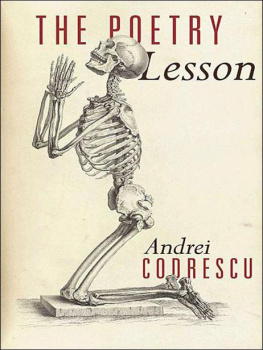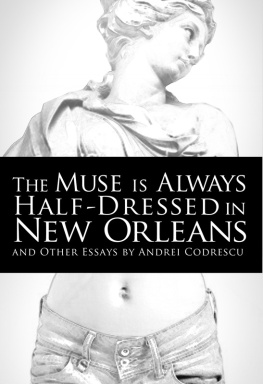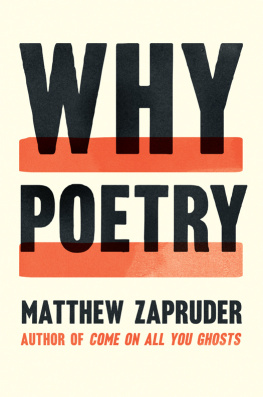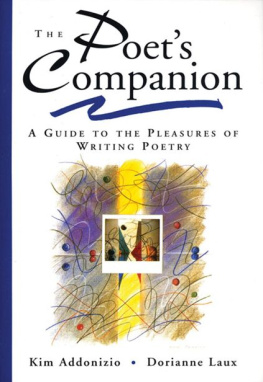
THE POETRY LESSON
Andrei CODRESCU
PRINCETON UNIVERSITY PRESS
Princeton & Oxford
Copyright 2010 by Princeton University Press
Published by Princeton University Press,
41 William Street, Princeton, New Jersey 08540
In the United Kingdom: Princeton University Press,
6 Oxford Street, Woodstock, Oxfordshire OX20 1TW
press.princeton.edu
All Rights Reserved
Library of Congress Cataloging-in-Publication Data
Codrescu, Andrei, 1946
The poetry lesson / Andrei Codrescu.
p. cm.
ISBN 978-0-691-14724-6 (cloth : alk. paper)
I. Title.
PS3553.O3P64 2010
813.54dc22
2010006053
British Library Cataloging-in-Publication Data is available
This book has been composed in
Printed on acid-free paper.
Printed in the United States of America
10 9 8 7 6 5 4 3 2 1
T HE DAY THE U NIVERSITY TESTED ITS TEXT-MESSAGE ALERT to every cell phone on campus, I assigned epitaphs to my Introduction to Poetry Writing class.
Every morning when you get up, write an epitaph! I watched them scribble something. Thats good, I encouraged them, start right away!, though I knew that what they were scribbling were not epitaphs, but every morning when you get up write an epi epipi epi
And while youre at it, turn off your cell phones! I always say this the first class of the semester, but I didnt realize that now they would be unable to receive the text-message alert test. If a real wacko wired to a bomb tried shooting his way to fame inside this very door, wed have been unwarned. I consoled myself with the fact that the Virginia Tech wacko who had killed fellow students had been enrolled in poetry class. If there was a wacko, he could be in my class, writing his epitaph.
An epitaph a day is like an apple a day, but the opposite, actually, because an apple a day keeps the doctor away, but an epitaph is ready if you happen to die that day. The apple part is rhymed poetry, the dying part is blank verse.
I gave them examples of famous epitaphs, by blank versepoets like Ted Berrigan, See you later, and Have a nice day, and by rhyming poets, such as John Keats, who only wrote part of his own epitaph, either because he died too young, or because his executors found it too terse: This grave contains all that was mortal of a young English poet who on his death bed in the bitterness of his heart at the malicious power of his enemies desired these words to be engraven on his tomb stone:Here lies One Whose Name was writ in Water, which doesnt rhyme, I explained, and not only doesnt it rhyme, but the poets name is entirely missing. In this regard, at least, they respected his wish even as they choked it in prose.
Its a good thing that when I visited the grave of John Keats in Rome in the Protestant cemetery where he is buried next to Gregory Corso, a cat who lives in the cemetery stole the panino with mortadella from my jacket pocket and made off with it in the direction of a pyramid built CE by a Roman senator during one of the periodic Egyptian crazes of the Romans. Too bad too, because I didnt have any money and Id gotten the sandwich from a nun in a charity-dispensing convent. Behind the grave of John Keats grows a lyre-shaped tree that is obviously pruned carefully, though the cemetery itself, at the time of my visit, was in a state of neglect. Next to John Keats is buried his friend Joseph Severn, whose epitaph notes that he is the friend of John Keats, the poet buried next to him. So that even though John Keatss name is missing from his own grave, he is made present by his dead friend next to him, which is a kind of rhyme. What does this tell us?
A skinny mop-styled redhead girl fingering what looked like a worry bead that was actually the earbud of her iPod said: That if you dont write your epigram you might have to rely on your friends?
Precisely. I now assign you in addition to an epitaph an epigram. For this class, you must also write an epigram every day. An epigram is a very short poem with a clever twist at the end that shows off your wit. For example, In my next life I will make a lot of croaking noises / but I will live a long time/because in my next life/I will be a gold frog/like the one that sits on your desk, father. This is an epigram I made up in the style of the Roman poet Lucian. Now, if I was in a hurry, I might combine my assignments into an epitogram, which is an epitaph plus an epigram, something like, I am a gold frog in this life/and I will leap at you/from behind this tombstone/when you are finished reading. And then I would jump out and scare the shit out of the poor pilgrim to my grave, who happens to be an executive for a U.S. insurance company with a penchant for poetry, like Wallace Stevens, who is vacationing by visiting the graves of important poets around the world. Can you identify the wit in this epitogram?
A boy with a crewcut spoke from the back: The price of gold, like, from the time the poet died and the time when the business guy was visiting?
Very astute. The business guy maybe was amazed by how cheap gold used to be when those poets lived and how much it was now, and he couldnt feel his amazement properly until he saw the poets graves. That was one weird cat, right, but Im not sure witty is the word for him. Before going to visit John Keats, he visited the following poets: Walt Whitman in Camden, New Jersey, Emily Dickinson in Amherst, Massachusetts, Edgar Allan Poe in Baltimore, Maryland, Tristan Tzara at the Montparnasse cemetery in Paris, France, GuillaumeApollinaire in the Pre Lachaise cemetery in Paris, France, where he also stopped briefly to say hello to Jim Morrison. He saw George Bacovia in Bac?u, Romania, Boris Pasternak in Moscow, Russia, before his tomb was desecrated by vandals in 2006, and Csar Vallejo in Montrouge, the communist cemetery in Paris, France.
I looked around the class to see if maybe Jim Morrison elicited recognition. A soft stirring. Nothing much.
What does this say about this man?
That hes rich? tried the future jokester-in-chief of the class, a square-shouldered boy named Bennigan. Class laughed. And that there are a lot of poets buried in Paris, France? Another boy slapped him five. Villanelles for you, Bennigan.
Yes, poets are buried in Paris to make it easier for tourists. Poets are one big family. Anyway, at each grave this man took pictures. A couple of years later when he was found shot dead in the small apartment he kept secretly in lower Manhattan, the police detective in charge of the case, Detective Emma Flores, took pictures of these photographs of the poets graves, framed along the walls. She believed that there was a connection. Frustrated by what she believed was her ignorance of poetry, she enrolled at the New School and took a beginner class in Writing Poetry with poet and teacherSharon Mesmer. You would be right to ask, Did she solve the case?
Nobody said anything.
The answer is no. Professor Mesmers method of writing poetry at that time, in the early years of the twenty-first century, consisted of entering a number of blog postings into a Googlator, a program that mixes up words in strange combinations and returns them to you in novel forms.
I thought that this was supposed to be a












